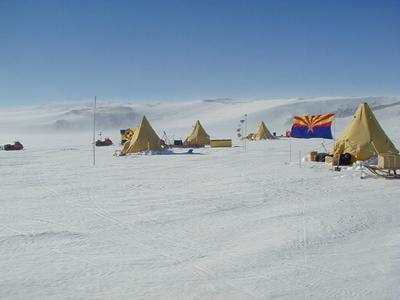6 January, 2003
Antarctic Geology
I thought I had felt the wind blow in Antarctica. Boy was I mistaken. The
Katabatic winds are pummelling our camp with 40 knot gusts and temperatures
well below 0F. Jamie and I figured the windchill to be -69F
(Excellent!) The horizon is fuzzy with suspended snow, although it doesn't
seem to be drifting too badly in camp. It is hard to stand up against this
wind, and even the most menial chores, like chipping ice or filling
campstoves, can be challenging. Even the tents have a huge temperature
gradient from top to bottom. While my body is comfortable, my feet get
cold. Luckily it's nothing a couple of toe warmers can't handle. When
people ask after we return if it was cold, today will be the day we think
about.
We are taking a tent day, of course. I woke up 1/2 hour late this morning,
checked the temperature inside the tent (+16F), and crawled right back into
my sleeping bag. I didn't even have to ask Jamie if we were staying in
today. At least this allows us to catch up on other duties. I'm working
on a PowerPoint for when I return, and Jamie is labeling the pictures he's
taken of each of the meteorites. I feel antsy if I'm not doing something
constructive.
Having a day like today also gives me the opportunity to study up a little
about Antarctica. The geology of this place is incredible. I often find
myself looking at the local rocks when I'm supposed to be looking for
meteorites. For a continent mostly covered by ice, a great variety of
rocks can be found here.
When Jamie, Scott, Carl, and I hiked up a small peak near camp the other
day, we stumbled across an outcrop of sandstone belonging to the Buckley
Formation. This sandstone was formed during the Permian time period about
320 million years ago. What caught our eyes were the numerous inclusions
of petrified wood that looked as if they were only a few years old! During
the Permian, Antarctica was part of a supercontinent, called Gondwanaland,
and existed further north than it does today. It probably had a tropical
climate and the sandstone we saw was most likely formed as part of a river
delta. John Schutt has actually found entire tree stumps, perfectly
petrified in a moraine not far from here. One of them is on display at the
Crary lab at McMurdo.
Overlying the Buckley, and dominating the landscape are mountains made of
the chocolate-brown Ferrar Dolerite. This dolerite is an intrusive igneous
rock formed about the time Antarctica was separating from the Gondwanaland
Supercontinent. Some fragments of the dolerite contain zeolites, small,
light-colored crystals that form in gas pockets after the magma has
cooled. The only other zeolites I've seen come from large basaltic lava
flows near Poona, India, and from South Table Mountain near Golden, CO.
Fossils are also found in this region of Antarctica. A dinosaur fossil of
an entirely new species was found nearby on Mt. Kirkpatrick. But more
significantly, fossils of a plant called "Glossopteris" are found in clays
all over this region. This is significant, because the same fossils are
found in South America and Africa today, strongly suggesting that the three
continents were once connected.
Possibly the most interesting rocks in this area come from Mt. Sirius, and
are called the Sirius Formation. They are described as forming from a
glacial till with waterlaid lenses and bands measuring up to three meters
thick. Dr. Ralph Harvey and an undergraduate, Hiram Boyd, from Cleveland
State University are working on a project to determine whether this rock
could have been formed from an offshore impact. This impact could have
sent a tsunami crashing on the continent depositing this rock. It's
exciting to see this kind of research in action.
My students often ask me whether I like astronomy better or geology, since
I teach both. I always respond, "Geology...because there is nothing
greater than being able to read the rocks like pages in a book." The rocks
tell a story. You don't have to be in Antarctica to read it.

Katabatic winds rage through our camp. Notice how hazy the mountains are in the background from snow cascading over the summits.
Contact the TEA in the field at
.
If you cannot connect through your browser, copy the
TEA's e-mail address in the "To:" line of
your favorite e-mail package.
|
